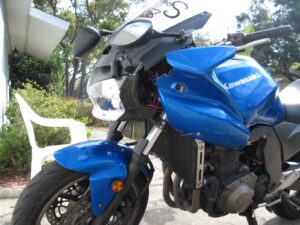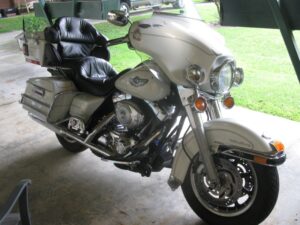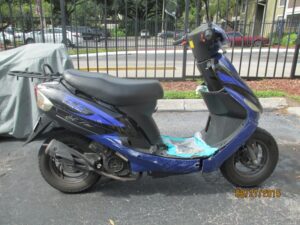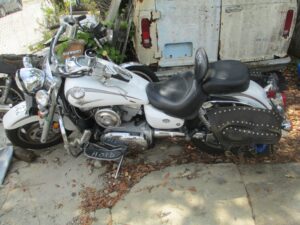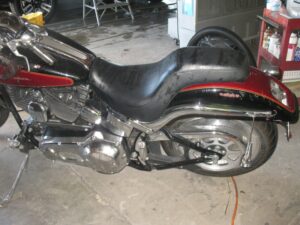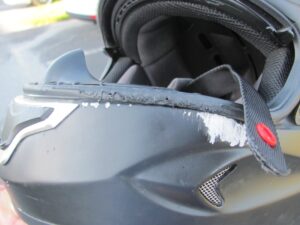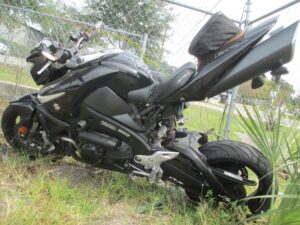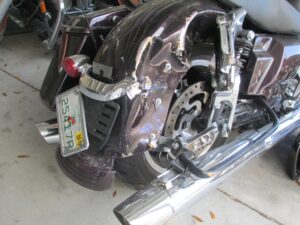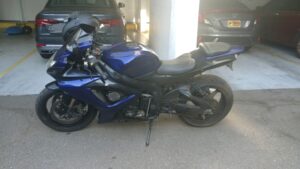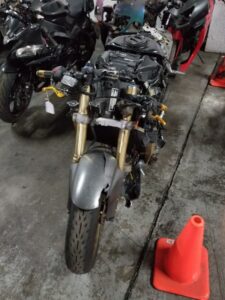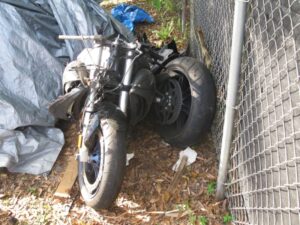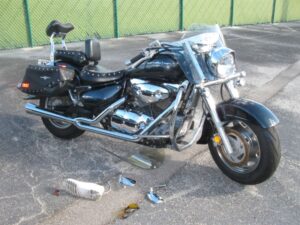Florida Motorcycle Accident Attorney Near You
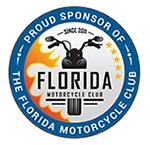
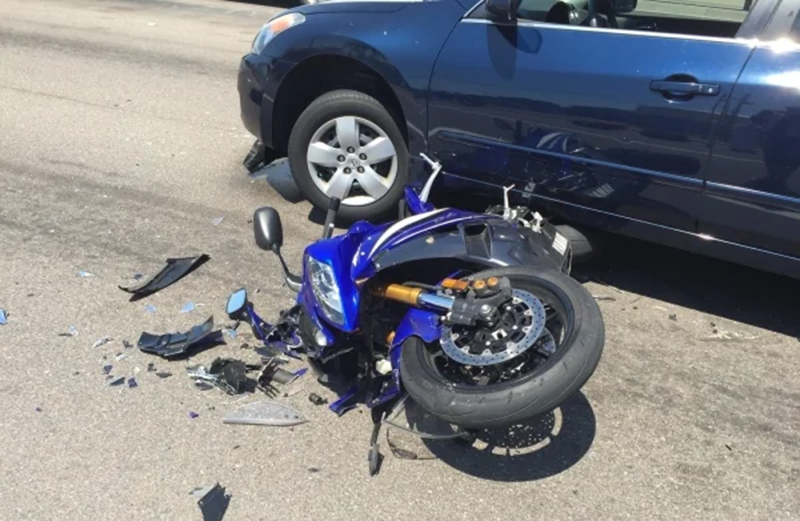
- Tampa Motorcycle Accident Lawyers
- Lakeland Motorcycle Accident Lawyers
- Clearwater Motorcycle Accident Lawyers
- St. Petersburg Motorcycle Accident Lawyers
- New Port Richey Motorcycle Accident Lawyers
- Palm Harbor Motorcycle Accident Lawyers
- Town ‘N’ Country Motorcycle Accident Lawyers
- Spring Hill Motorcycle Accident Lawyers
- Pinellas Park Motorcycle Accident Lawyers
- Brandon, FL Motorcycle Accident Lawyers
Find a Great Florida Motorcycle Accident Attorney
Accidents are, at times, unavoidable if you ride a motorcycle for any length of time. Knowing how to be safe, where you’re safest, and what to do once you’ve actually been in an accident can make a difference in your outcomes after the accident.
Call us 24/7 at 800-538-4878 to get your FREE case review.
¿Necesitas ayuda en Español?
Actual Cases Where We Have Helped Clients
Client Reviews for our Motorcycle Accident Attorneys
What Our Clients Say:

The Abrahamson & Uiterwyk Attorneys and Injury Law Team
“A system of hiring an attorney on an hourly basis rewards inefficiency, creates delays and commonly creates negative issues between the lawyer and the client. Representing clients on a contingency basis in which the law firm earns a percentage of the settlement, however, is much more rewarding for the client and the injury attorneys.”
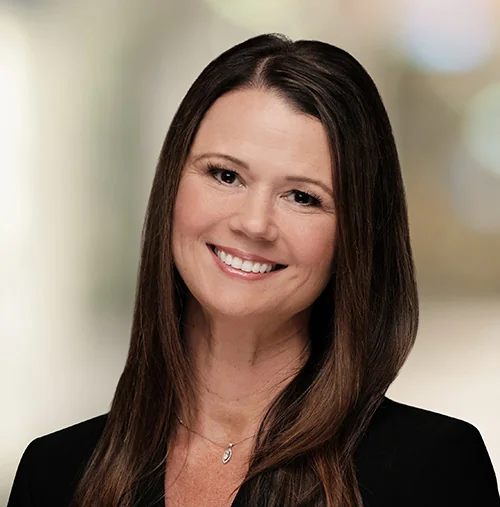
Client Services Manager
Kelly Anne Kelly
As a Client Services Manager, Kelly’s focus is to enhance client satisfaction by continuously looking for ways to fulfill clients’ needs and concerns.
How Hiring Abrahamson & Uiterwyk Made a Big Difference in Our Clients’ Compensation
| Initial Offer | Final Result | The AU Difference |
|---|---|---|
| $1,500,000 | $5,000,000 | $3,500,000 |
| $0 | $5,000,000 | $5,000,000 |
| $300,000 | $1,600,000 | $1,300,000 |
| $0 | $1,575,000 | $1,575,000 |
| $675,000 | $1,330,000 | $655,000 |
| $0 | $1,260,000 | $1,260,000 |
| $450,000 | $1,250,000 | $800,000 |
| $300,000 | $1,074,168 | $774,168 |
| $500,000 | $1,000,000 | $500,000 |
| $80,000 | $938,077 | $858,077 |
| $125,000 | $690,000 | $565,000 |
| $7,500 | $650,000 | $642,500 |
| $50,000 | $775,000 | $725,000 |
| $58,644 | $525,000 | $466,356 |
| $9,000 | $450,000 | $441,000 |
| $55,000 | $455,000 | $400,000 |
| $65,000 | $650,000 | $585,000 |
| $55,000 | $500,000 | $445,000 |
Motorcycle Accident Settlement Results
We have achieved significant motorcycle accident settlements and verdicts for our clients. Below are a few examples of results we’ve fought to obtain for our motorcycle accident injury clients.
Past results do not guarantee a similar outcome in your case.
-
$11,100,000VerdictOur client was riding his motor scooter on the Melbourne Causeway (US 192) when he was rear-ended by the at-fault driver.
-
$5,050,000SettlementPlaintiff was riding on a motorcycle when he was struck by Defendant. As a result of the impact Plaintiff was ejected and killed instantly.
-
$5,000,000VerdictA 34-year-old male who was riding his motorcycle when a tractor-trailer turned left into his right of way. The collision caused his death. He was survived by his wife and two minor children. Case was...
-
$4,899,000SettlementMinor male was seriously injured while riding a motorcycle with his father. The defendant changed lanes in front of the motorcycle causing the motorcycle to strike the rear of the defendant’s vehicle. The minor male...
-
$1,330,000Settlement63-year old male sustained a fractured pelvis, a right knee injury and a back injury when the defendant turned directly in front of the client while the client was on a motorcycle. The client’s fractured...
-
$1,269,936VerdictOur client was on his motorcycle approaching a large car carrier truck which had negligently parked in the road without any warnings. As a result, he ended up going up the ramp of the car...
The Numbers Behind Motorcycle Safety In Florida
Fatalities related to motorcycle accidents continue to increase. According to RIDESmartFlorida.com, in 2020 516 motorcycle riders died in Florida, 34 fewer than 2019. According to the National Highway Traffic Safety Administration, there were 5,014 motorcycle fatalities in 2019 for the entire United States – down just 14 from 2018.
The fatalities in Florida for 2020 represented approximately 16.5 percent of all automotive deaths for the year, even though motorcycles only account for 3 percent of the vehicles on the roadway. Proponents for Motorcycle Safety Awareness hope to raise visibility for the issue of motorcycle safety in an attempt to decrease the number of fatalities and serious injuries that are attributed to motorcyclists.
Causes Of Motorcycle Accidents In Florida
Motorcycle accidents in Florida can happen due to a number of factors. Some common causes include:
- Lack of visibility
- Drinking
- Speeding
- Overestimating abilities
It’s important when operating a motorcycle to make sure you always wear a helmet as well as high visibility reflective clothing when possible. There are many other bike safety tips you can use to reduce your risk of a motorcycle accident as well.
Motorcycle Accident Statistics
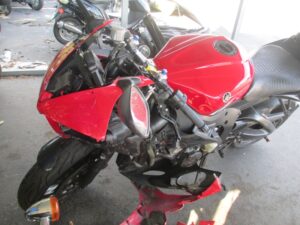
Head injuries are the most common cause of death for motorcycle accident victims. In the United States nearly sixty percent of fatalaties in a motorcycle accident were caused by head injury. Using helmets is associated with a 39 percent effectiveness rating. (source)
A study by AAA analyzed federal crash data and found that the fatality rate for motorcycle riders aged 60 and over rose more than 20% over recent years. This is 4 times more than the overall 5% increase in motorcycle fatalities.
Over the past decade, the median age for motorcyclists involved in fatal crashes has increased substantially. This is due in part to the fact that the number of motorcyclists aged 65 and over has increased by 33% over the past decade. If there is a large number of older bikers on the road, the risk of accidents resulting in a fatality is higher. There are other factors, however, that can explain the increase in fatalities.
Call us 24/7 at 800-538-4878 to get your FREE case review.
¿Necesitas ayuda en Español?
The Most Dangerous Motorcycle Accidents by Type in Florida
According to the National Highway Traffic Safety Administration (NHTSA), motorcycle riders continue to be overrepresented in traffic fatalities.
The smaller size of the motorcycle may be harder for other drivers to see, especially if they are driving distracted. But what are the most dangerous motorcycles?
Why Motorcycle Accidents Are So Dangerous
There are two reasons why a motorcycle accident is often far worse than an accident involving cars: speed and size. First, motorcycles are generally capable of traveling at much higher speeds than the average car. Although riders must speed to reach a motorcycle’s limits, they may feel the desire to do so along stretches of open road.
Second, motorcycles are small compared to a majority of other vehicles on the road. According to the Highway Loss Data Institute at the Insurance Institute for Highway Safety (IIHS), 63% of all motorcyclist deaths involve at least one other vehicle.
In a wreck with a car, the motorcycle and its rider will experience far more damage. In addition, riders have little to no protection other than their riding gear.
Most Dangerous Motorcycles
A big part of a motorcycle’s safety comes down to the rider. Wearing a helmet and proper protective gear and riding the speed limit can reduce some of the risk. But for a variety of reasons, riders don’t always take those precautions. Here are common motorcycle types and what makes these motorcycles dangerous.
Street or Sport Bikes
Street bikes and sport bikes are stylish, mean-looking motorcycles loved for their high speed. Although they come in a variety of engine sizes, sport bikes often have larger engines for more power.
What Makes Them Dangerous
Sport bikes (including SuperSport motorcycles) are dangerous primarily because of their speed. Right “out of the box,” sport bikes are capable of traveling over 200 miles per hour. Obviously, a rider must be extremely skilled to handle a bike at that speed, but these bikes appeal to riders of all skill levels.
While going that fast may be thrilling, many riders are without safe opportunities to do so. Nevertheless, it can be tempting to open up the throttle on long stretches of highway or even down straight city streets.
However, these higher speeds mean less time to react and more opportunities to lose control. In addition, the flashy style of many sport bikes is alluring to younger, less experienced riders.
Motorcyclists in the “under 30” age group made up over half of the motorcycle fatalities involving sport bikes. By speed alone, sportbikes are one of the most dangerous motorcycles.
Cruisers
There’s very little statistical data discussing motorcycle accidents by type. But the data that is out there paints an interesting picture. Nearly half of all motorcycle rider deaths occur on bikes with an engine size of 0-1000 cc.
Cruisers typically come with an engine size of between 250 and 1800 cc, making them a large portion of this engine class.
What Makes Them Dangerous
Cruisers are undeniably the bike of choice in the U.S., making up over half of all motorcycle sales. Because there are so many cruisers on the road, it is inevitable that more accidents will involve them.
Unfortunately, they are also more dangerous because of the culture of their riders. Riders on a cruiser may be more interested in style than safety, forgoing a traditional motorcycle helmet for less-safe “bucket-style” helmets. In addition, cruiser riders are more likely to follow a “forget the rules” lifestyle.
Combine that with a more leaned back riding style that newer riders may have more trouble with, and you have one of the most dangerous motorcycles out there.
Retro & Kit Bikes
Older motorcycles, kit bikes, and cafe racers are lightweight, stripped down motorcycles that can offer a chance for customizations. This DIY nature makes them popular among riders of all age groups and experience levels.
What Makes Them Dangerous
Not all bike owners are expert mechanics. As a result, modifications to their motorcycles may end up making them unsafe to drive. In addition, because these bikes have very little extra body work, they offer even less protection to a rider than other motorcycles.
Touring Bikes
Touring bikes are designed with one thing in mind: long rides equipped with some of the practical accessories absent on other types of motorcycles. Adventure touring bikes are a subset of tourers suited for both highway hauls and off-road exploration.
What Makes Them Dangerous
Even if they don’t travel at as high speeds, tourers are on the road longer. What’s more, they are usually much heavier; the average weight of a touring bike is around 900 pounds, while sport bikes and cruisers are roughly half that. The heftier weight can make these motorcycles harder to control.
In addition, older riders more commonly favor adventure tourers. In the IIHS study, 64% of fatalities involved a touring motorcycle also involved a rider over the age of 50. Even if they have riding experience, older riders may be slower to react to emergency situations on the road.
Dirt Bikes
Dirt bikes are lightweight machines designed for taking jumps and riding off-road courses and trails. Like sport and street bikes, dirt bikes are favored by younger riders for their speed and the thrill of racing through a wooded glen.
What Makes Them Dangerous
In this case, it isn’t so much the bike itself that is dangerous, but the way it is used. Dirt bikes are at home along narrow dirt tracks up in the mountains or on twisting courses with jumps and moguls. Combined with the rough, sometimes uneven terrain and a top speed of over 100 miles per hour, it’s no wonder dirt bikes are dangerous.
Like other off-road activities, riding a dirt bike is also riskier because emergency medical treatment may take longer to arrive. Depending on where you are, medical personnel may have difficulty reaching you.
Motorcycle accidents tend to involve more serious injuries, to begin with since the rider is more exposed than in a car. As a result, prompt medical treatment can be the difference between recovery or significant long-term injuries. Read more on Tampa dirt bike laws.
Motorcycle Accidents: Who Is To Blame?
When you get injured in a motorcycle accident, one of the first questions you need answered is, “Who is to blame?” If the accident was someone else’s fault, you are entitled to financial compensation, and it will be important for you to speak with a Florida motorcycle accident lawyer as soon as possible.
Common Causes of Motorcycle Accidents
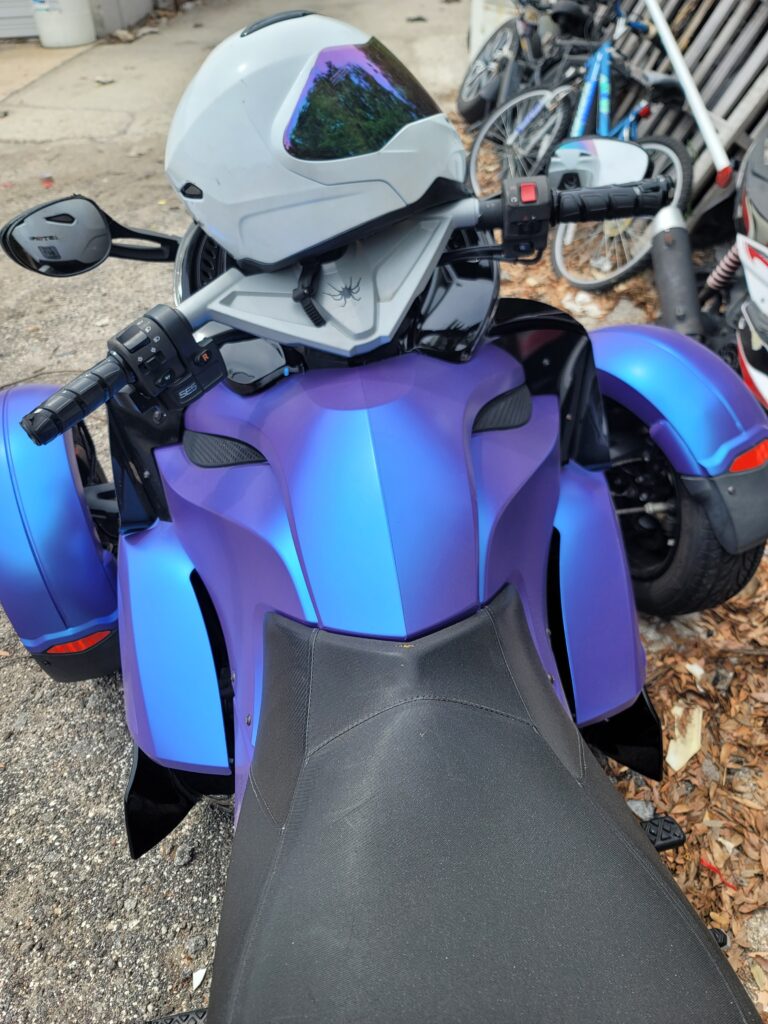
Motorcycle property damage of one of our many motorcyclist clients
While many people assume that motorcycle riders are reckless, the reality is that the vast majority of collisions involving motorcycles are the result of driver negligence. Drivers routinely make mistakes that put riders in harm’s way—and, when they do, they deserve to be held accountable.
Whether you were injured while riding a cruiser, street bike, or any other type of motorcycle, an experienced motorcycle accident lawyer in Florida may be able to help you pursue a claim based on forms of driver negligence such as:
- Distracted driving
- Drunk driving
- Fatigued driving (or falling asleep behind the wheel)
- Speeding, tailgating, and/or braking too late
- Turning, merging, or backing up without looking for oncoming motorcycles
These are just examples. Many other types of driving mistakes can leave riders on cruisers and other motorcycles helpless to avoid a collision as well.
But, while driver negligence is among the leading causes of motorcycle accidents, filing a claim against a negligent driver isn’t necessarily your only option after a serious collision. In some cases, other parties can be liable as well. For example, depending on the circumstances involved in your accident, a Florida motorcycle attorney may also be able to help you pursue a claim based on:
- A vehicle or motorcycle defect
- A helmet or safety gear defect
- A road maintenance issue or defect (i.e., a pothole or low shoulder)
- Employer liability (if the driver who hit you was working at the time of the accident)
- Rideshare company liability (if the driver who hit you was logged in to the Uber or Lyft app)
In short, there are lots of possibilities when it comes to filing a successful claim after a motorcycle collision. But, to determine which options you have available—and to pursue the full compensation you are entitled to recover—you will need an experienced Florida biker attorney on your side.
What if you were partially at fault in your motorcycle accident?
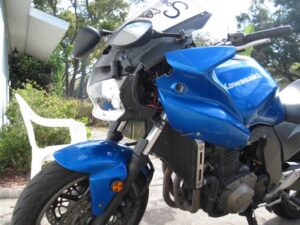
So, what if you were partially at fault in your motorcycle accident? Due to a change in the law that took effect in 2023, the short answer is, “It depends.”
In Florida, you used to be able to recover partial compensation regardless of your percentage of fault in a motorcycle accident. Even if you were 90% at fault, you could theoretically still recover 10% of your accident-related losses. But, this is no longer the case. Now, if you are deemed more than 50% at fault, you are not entitled to any compensation for your accident-related losses.
This is yet another reason why it is important to have an experienced Florida motorcycle accident attorney on your side. The insurance companies routinely try to blame riders for their own injuries; and, now, they have even more of an incentive to do so. Your attorney can deal with any allegations of partial fault for you, and your lawyer can fight to make sure you receive the full financial compensation you deserve.
Florida Motorcycle Case Settlement Example
$280,000/Motorcycle Accident/2023
Our client is an owner/operator of a motor sports company in Spring Hill, Florida. Unfortunately, while riding his motorcycle in Hernando County, the defendant, who was heading in the opposite direction, attempted to make a left turn directly into the path of our client. This resulted in a serious collision, with our client being ejected from his motorcycle. The defendant was found to be at fault and was cited by the Florida Highway Patrol.
Our client was rushed to the hospital, where it was determined that he had sustained numerous broken bones, including in his back and pelvis. These injuries involved extensive treatment and rehabilitation, although no surgery was required. Our client missed an extended period from work as well due to his injuries.
In this case, we filed suit early because Florida was passing a new law which would have a negative effect on the rights of injured people. By filing the lawsuit before the new law was enacted, we protected our client’s rights under the existing Florida law. We then send a detailed settlement package to the defendant’s insurance company demanding that they tender their policy limits of $250,000.00 to our client by a date certain. Fortunately, after receiving our package, the company was convinced to tender its full limit to our client. We were also able to secure payment of our client’s uninsured motorist coverage in the amount of $30,000.00 for a total settlement of $280,000.00.
Injured in a Motorcycle Accident?
The Florida motorcycle accident lawyers at Abrahamson & Uiterwyk have over 30 years of experience representing clients injured in motorcycle and auto accidents. During that time, we’ve helped over 20,000 clients recover hundreds of millions of dollars in settlements and compensation. Check out our page for more motorcycle crash settlement examples or for average hip injury settlements. If your accident was in Kissimmee, contact a personal injury attorney in Kissimmee today. Learn more about how to manage a motorcycle degloving injury for optimal recovery.
Call us 24/7 at 800-538-4878 to get your FREE case review.
¿Necesitas ayuda en Español?
What to Do After a Florida Motorcycle Accident
Knowing what to do after a motorcycle accident can play a key role in protecting your rights in the event you’ve been seriously injured. If you’ve been in a motorcycle accident, follow these steps:
- Seek medical attention. This is always your first and most crucial step. Since motorcycle riders don’t have the protection of a vehicle when they’re in a crash, their injuries tend to be much worse. Of course, it’s always kind to help those around you seek medical attention as well, but first and foremost, make sure your own injuries are attended to
- Call the police. Report the accident and have law enforcement document it. Do not leave the scene before the police arrive, or until they’ve taken a full report (unless your injuries require an emergency trip to the hospital).
- Get information you may need. This includes contact and insurance information from all drivers, victims, and witnesses. It’s ideal if you can get the make, model, and license plate numbers of all vehicles involved as well.
- Record the events. If you have a cell phone camera and can take pictures of your injuries, the damage to your vehicle, and the scene of the accident, do so immediately.
- Get an attorney. Many accident victims miss or minimize this important step. However, without an experienced attorney, you may lose out on compensation you may be entitled to.
What Not to Do After a Motorcycle Accident
Along with knowing what to do after a motorcycle accident, it is important to know what not to do as well. While you will need to speak with a motorcycle attorney in Florida to learn about all of the mistakes you need to avoid, here are some basic tips for what not to do while your case is pending:
- Do not give your photos or videos to the insurance companies. While it is important that you document the accident as thoroughly as possible, you should only share your photos and videos with your attorney. Your attorney will decide when (and if) it makes sense to share them with the insurance companies.
- Do not ignore your doctor’s advice. Ignoring your doctor’s advice can be detrimental to your health and your legal rights. If you prioritize your health, this will help ensure that you are able to recover just compensation.
- Do not accept an insurance settlement. While it may be in your best interests to accept a settlement eventually, you should not resolve your claim until you speak with a motorcycle accident attorney in Florida. Don’t forget, the insurance company’s goal is to pay you as little as possible.
- Do not post about the accident on social media. If you post photos or comments on social media, the insurance companies may find a way to use them against you. As a result, it is best to avoid posting while your case is pending.
- Do not try to handle your case on your own. If you have been seriously injured in a motorcycle accident, you have too much at stake to take chances. Rather than trying to handle your case on your own, you need to rely on the advice and representation of an experienced Florida motorcycle accident lawyer.
Call us 24/7 at 800-538-4878 to get your FREE case review.
¿Necesitas ayuda en Español?
Florida Injury Case Types
The highly-experienced Florida personal injury law firm of Abrahamson & Uiterwyk also provides:
- Car accident lawyers in Florida
- Guide to Florida Car Accident Law
- Motorcycle accident lawyers in Florida
- Slip & fall lawyers in Florida
- Truck accident lawyers in Florida
- Bicycle accident lawyers in Florida
- Brain injury lawyers in Florida
- Birth injury lawyers in Florida
- Pedestrian accident lawyers in Florida
- Florida Red Light Car Accident Settlement Lawyers
- Construction accident lawyers in Florida
- Wrongful death lawyers in Florida
- Actos injury lawyers in Florida
- Boating accident lawyers in Florida
- Business interruption insurance lawyers in Florida
- Defective drugs medical device lawyers in Florida
- Dog bite lawyers in Florida
- Drunk driving accident lawyers in Florida
- Insurance disputes lawyers in Florida
- Medical malpractice lawyers in Florida
- Metal hip knee implant lawyers in Florida
- Nursing home abuse lawyers in Florida
- Product liability lawyers in Florida
- Work injury / workers comp lawyers in Florida
Your Rights and Obligations as a Motorcycle Rider in Florida
Under Florida’s motorcycle accident laws, you have both rights and obligations as a rider in the Sunshine State. For example, as a motorcycle rider, you have the right to occupy your entire lane, and you have the same rights as all other road users. But, this means you have the same obligations as well. As a result, motorcycle riders need to obey the speed limit, leave plenty of buffer, observe all traffic signs and signals, and always avoid getting in the saddle while under the influence of alcohol or drugs.
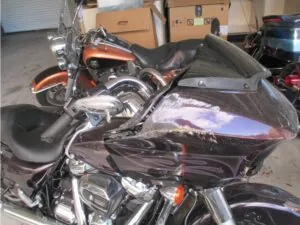
Motorcycle Safety Tips
Motorcyclists should do their part to stay safe. Operating a motorcycle takes different skills than driving a car, so it is important to take steps to stay safe, such as:
Wear a Helmet
One of the most important things you can do to protect yourself on a motorcycle is to wear the proper helmet. Helmet use saves lives. The National Highway Traffic Safety Administration provides information on how to pick and care for a motorcycle helmet.
Get the Correct Size
Determining whether a motorcycle helmet is the correct size goes beyond determining if you are “small,” “medium,” or “large.” The ideal fit involves determining head size. Measure the circumference of your head and compare it to the size charts manufacturers put together for each helmet. Ensure that your helmet fits you correctly. A correctly sized helmet will move slightly but will pull on the skin of the scalp and face to prevent rotation or large movements. Make sure to try on the helmet before purchasing it to ensure the correct fit and comfort. A new helmet should generally fit more snugly because it becomes a little looser after use. The helmet should be snug on your head, but you should not feel pressure or pinching.
Choose the Safest Motorcycle Helmet Type
There are numerous styles of helmets, but the three main types are full face, ¾, and ½. Full-face helmets are generally the safest because it offers the most coverage surrounding your face and neck. A full-face helmet also includes a chin bar which other helmets lack. Chin bars can protect you from serious injury if your face hits the pavement in an accident. You should also make sure your helmet has a thermoplastic or reinforced composite shell-like polycarbonate. You should also look for a helmet that has an impact-absorbing liner and a chin strap. Make sure your helmet has a thermoplastic or reinforced composite shell. It should always fasten to the right.
Motorcycle Helmet Safety Standards
Motorcycle helmets must meet standards laid out by the Department of Transportation. Approved helmets should have a “DOT” sticker. This label signifies the manufacturer’s certification that the helmet meets federal regulations. Some motorcycle helmet manufacturers go beyond those standards and strive to comply with standards set out by the Snell Memorial Foundation. These standards, while not required in the United States, go above and beyond the minimum criteria and include helmets that have passed:
- Impact testing
- Positional Stability (Roll-Off) Test
- Dynamic Retention Test
- Chin Bar Test
- Shell Penetration Test
- Face Shield Penetration Test
Helmets that meet Snell standards have been rigorously safety tested. Look for indications that your helmet has met these standards (Snell Foundation certification is not a requirement, but they go above and beyond when testing helmets).
While helmets can go a long way toward protecting you in an accident, they can’t prevent all injuries. If you’ve been injured in a motorcycle accident, contact the trusted motorcycle lawyers at Abrahamson & Uiterwyk online or call us at 1-866-496-1875 to schedule your free consultation.
Motorcycle accident client we obtained settlement for
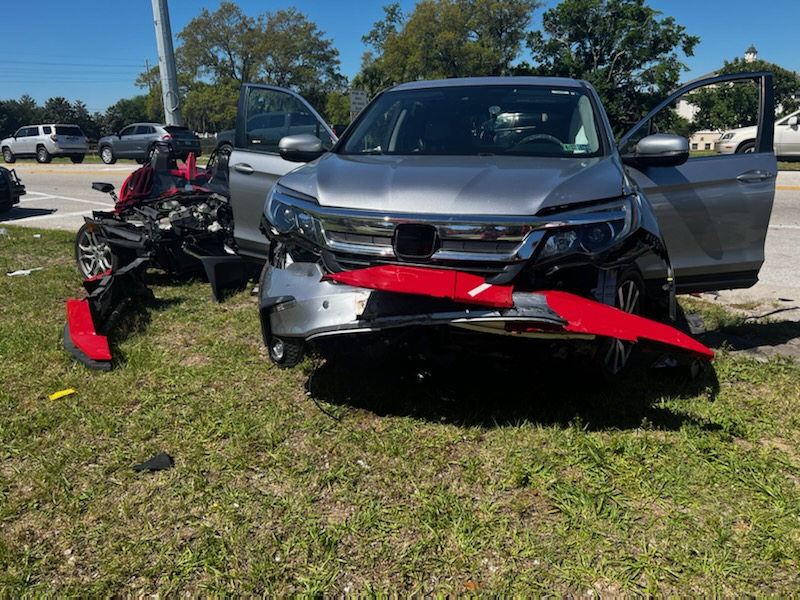
Wear Protective Gear
Protective clothing and gear can help minimize injuries in case of an accident.
Secured Jacket
A jacket that is specifically designed to protect a motorcyclist’s body is important. Jackets should have impact-absorbing material to protect the body (such such as leather or specialty synthetic material). Jackets should be long-sleeved. Check for the “CE” rating on any jacket you purchase.
Protective Pants
Motorcycle pants should fit snugly but should also allow you to move around freely. The pants should have CE-rated armor in the hips, shins, and knees. Zipping your pants to your jacket can make you more secure. Try to find pants made by the same manufacturer as your jacket and ensure that they are compatible. If possible, a full body motorcycle suit is safest. Pants also should be made of durable material, such as leather or specialty synthetic material. They should be full-length pants (not shorts) to avoid abrasion in the event of a fall. Pants should not be baggy or loose at the bottom to prevent entanglement in protrusions such as the kick-starter, footpegs, or chain.
Gloves
Protect your hands and wrists with the right gloves. Make sure your glove has a wrist retention strap to prevent the gloves from falling off. The gloves should provide full coverage of your hand. There should be no skin exposed between your jacket and your gloves. Gloves made of products such as Kevlar are best for protecting against abrasions and other injuries. Leather gloves are highly recommended, as well as specialty gloves with leather on the fingers and palms. Gauntlet-type gloves come up higher on the forearm which helps keep air out of the rider’s sleeves. Gloves must be durable and non-slip to ensure a firm grip on the controls.
Boots & Footwear
Motorcycle Boots: Motorcycle boots should be oil-resistant, have non-slip soles, and offer good ankle support. Try to choose soles with a metal plate in them to prevent twisting. Always make sure to lace your boots securely above the ankle.
Motorcycle Footwear: Footwear includes protection of not only the feet but ankles and legs. Leather boots are again recommended. Athletic shoes are suggested as a good alternative. With shoes that lace, care should be taken to avoid the laces getting in the way. Shoes such as sandals and sneakers that provide little protection should not be worn.
Eyewear
Good vision is imperative when driving and some helmets do not have a face shield. Eyewear emulates the windshield of a car, protecting from airborne materials like bugs, dirt, and rocks. Wind can be extremely harmful to the eyes as well, causing tearing and blurred vision. Even with a shield eye protection is recommended. Goggles or glasses should have scratch-free, shatterproof, plastic, or safety lenses. They should also be well ventilated to compensate for fog. Eyewear used at night should not be tinted.
Stand Out with Reflective Material
It’s up to all Florida drivers to share the road with motorcyclists by staying aware of our surroundings and giving riders plenty of room. That having been said, it’s important for riders to do their part by ensuring that other drivers can easily see them when they’re on the road.
Reflective material is an extremely important component of protective gear, especially on the upper body. Being noticed can be a good thing when you are on your motorcycle when it comes to staying safe on local roads in our area. Riders who take basic precautions to ensure other drivers are aware of their presence lower their chances of being involved in a Florida motorcycle accident. Retro-reflective material should be used on clothing, the helmet, and the actual motorcycle. Reflective material is imperative, especially at night, to be visible to other drivers. There’s even some riding apparel that is only particularly reflective at night, giving riders some nice options for style.
- Helmet: Incorporate reflective strips of some kind onto your motorcycle helmet. There a wide variety of reflective stickers available to suit a rider’s personal tastes, and using them is an easy way to ensure that you are spotted by other drivers.
- Jacket: Wear a jacket that will help you be seen by other drivers. Brightly colored jackets are noticed much more easily than brown or black clothing. If you choose to wear a dark-colored jacket, consider adding reflective tape or bright embroidered patches to your ensemble. Some motorcyclists wear lightweight orange or yellow vests over their jackets.
- Running Lights: Ensure that your daytime running lights are turned on and operational. This is a standard feature of most of the newer bikes, but bikers riding older models may need to remember to use their low beams during the day.
- Headlight Modulator: Consider adding a headlight modulator to your bike. These devices make your headlights appear to become briefly brighter and dimmer while you ride, which attracts the attention of other drivers. Be sure to use a headlight modulator that has been approved by the Department of Transportation and make sure that you are in compliance with the legal regulations in your area if you choose to use these devices.
- Color of the Bike: Consider avoiding a black motorcycle. This may be a deal-breaker for some riders, but the fact remains that black motorcycles don’t stand out as well as most other bikes. If you choose to ride a black motorcycle, make sure to follow other tips on this page and from government officials.
By making yourself and your vehicle stand out visually, you’ll be less likely to be seriously injured due to the negligence of another driver.
Obey Traffic Rules
Motorcyclists aren’t exempt from traffic rules so make sure you are riding under the speed limit, following traffic signals, and don’t break the rules by engaging in dangerous maneuvers like lane-splitting.
Ride Defensively
While motorists have an obligation to be aware of motorcycles, don’t assume that you are visible to other vehicles. Always keep your headlights on, try to stay out of a driver’s blind spot, and signal in advance of any change in direction.
Unfortunately, even the most responsible riding practices cannot guarantee that another driver’s irresponsible behavior won’t put you at risk. Be sure to give other vehicles plenty of room when you are on the road, and never assume that you know exactly what another driver is going to do next.
Blind Spot Awareness
A blind spot is an area of the road that cannot be seen by a driver looking through the front windshield, side view mirrors, or rearview mirrors. All vehicles have blind spots to the side and rear to the left and right. Be aware of where your bike is in relation to other people’s line of sight. Remember, if you can’t see the faces of other driver’s from your mirrors, there’s a good chance that they can’t see you. While there’s not much a motorcyclist can do if a driver fails to check behind them, there are steps that can be taken to avoid being in someone’s blind spot.
- Be aware of where a vehicle’s blind spot may be. Keep in mind that the larger the vehicle, the larger the blind spot. This is especially true for large commercial trucks.
- If you can’t see the driver in their side view mirror, then the driver can’t see you
- Do not travel beside another vehicle as that is often where the blind spot is. Stay slightly ahead or slightly behind to remain visible.
Call us 24/7 at 800-538-4878 to get your FREE case review.
¿Necesitas ayuda en Español?
How to Safely Share the Road With Motorcycles
Avoiding accidents and keeping the roads safe is the responsibility of drivers of all types of vehicles. Drivers of cars, trucks, 18-wheelers, and motorcycles must be aware, not only of what they are doing, but what the vehicles around them are doing. It’s important for drivers to be mindful of sharing the road with motorcycles and motorcycle safety. Motorcyclists are more likely to be seriously injured in an accident with a car or truck because they are less visible and less protected than other drivers. Anticipating and properly reacting to the moves of other drivers can save lives and prevent serious accidents. To keep motorcyclists safe on the road, it’s important to follow these tips:
Check Your Mirrors and Blind Spots
Motorcycles can be hard to see, especially when they’re in your blind spot. Check your mirrors, but also be sure to turn around and check your blind spots before changing lanes or turning. One of the most common causes of accidents involving motorcycles is a failure by drivers to check their blind spots. It is more difficult to see a motorcycle than it is to see other vehicles. It is important to always triple-check your mirrors and blind spots when making turns or changing lanes. Checking blind spots for other vehicles/motorcycles is the responsibility of all drivers. Many motorcycle accidents in Florida are the result of drivers not seeing a motorcycle and hitting them.
- Adjust your rearview mirror so you can see the entire rear window of your vehicle from the passenger seat.
- To properly adjust the driver’s side view mirror, place your head against the window and adjust the mirror to where you can barely see the side of your car.
- To properly adjust the passenger’s side view mirror, place your head above the center console and adjust the mirror so you can barely see the side of your car.
- Always turn and check your blind spot before turning, changing lanes, and backing up. If you only use your mirrors when changing lanes, you are not driving safely.
Give Motorcycles Space
- Give Them the Whole Lane: When you come up on a motorcycle, give them room to drive safely. Motorcycles are entitled to an entire lane on the road. It is extremely dangerous to attempt to share a lane with a motorcycle.
- Give Them Extra Room: Treat motorcycles like other vehicles and don’t follow too closely. Many motorcycles come to a rolling stop, and you may not see their brake lights, so it’s important to be aware of their movements. Because motorcycles stop differently from other vehicles, it’s important to leave plenty of stopping distance between you and the motorcycle.
- Beware of Lane Splitting: Although it is illegal in Florida, be aware of lane splitting. The motorcycle behind you may make a sudden move and go between your vehicle and the vehicle next to you.
Be Careful When Passing
Avoid cutting off motorcycles when passing. If you pull in front of a motorcycle without leaving enough space, you can cause the rider to over-brake, resulting in a slide or a fall. In addition, don’t attempt to share a lane with a motorcycle when passing. Give them full use of the entire width of the lane.
Don’t Drive Distracted
Using a phone, texting, or fiddling with your navigation system can take your attention off the road. This is especially dangerous when faced with the low visibility of motorcyclists. Turn off the distractions and keep your focus on the road. The best thing you can do to keep motorcycles safe is to stay alert and keep in mind that you’re sharing the road with motorcycles.
A Biker We Represented
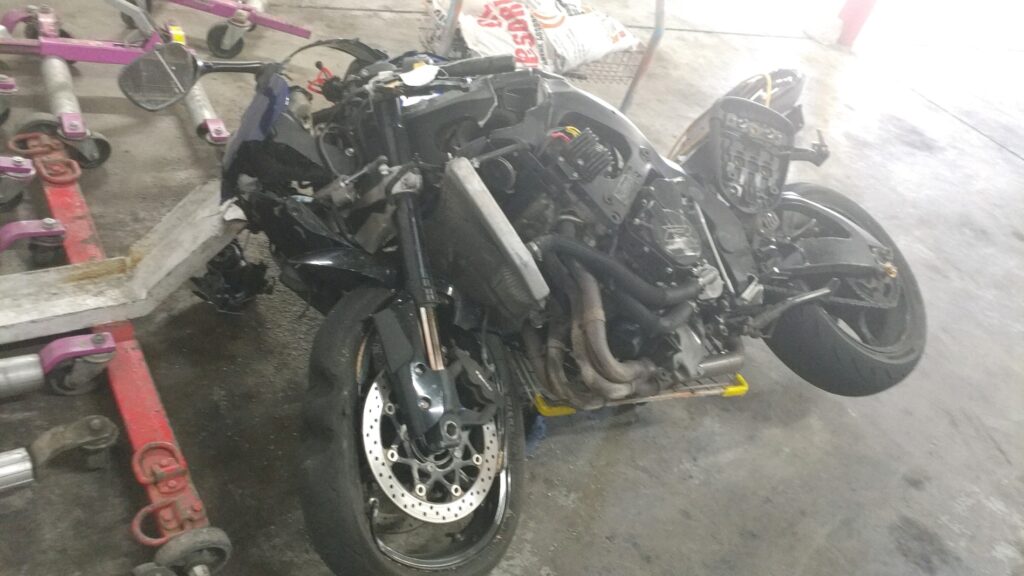
Call us 24/7 at 800-538-4878 to get your FREE case review.
¿Necesitas ayuda en Español?
When Should You Hire a Florida Motorcycle Accident Lawyer?
Do you need a Florida motorcycle accident lawyer? If so, when should you hire one?
If you have been injured in a motorcycle accident, you should speak with a lawyer as soon as possible. Understanding your legal rights isn’t easy, and you can easily fall victim to the insurance company’s tactics if you aren’t careful. Your lawyer can explain everything you need to know—including the mistakes you need to avoid—and your lawyer can deal with the insurance companies on your behalf. In some cases, if your attorney can’t negotiate a fair settlement with the insurance company, they may recommend filing an insurance lawsuit. Learn more about Farmers insurance lawsuits as well as other insurance disputes.
Depending on the circumstances of your accident, you may or may not have a claim. If you have a claim, the amount you are entitled to recover can vary widely. When you contact a lawyer, you don’t need to know anything about your legal rights. Your lawyer will assess your legal rights for you, and then you can make an informed decision about what to do next.
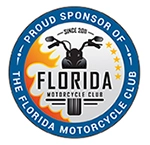
What Should You Expect From Your Florida Motorcycle Attorney?
In addition to questions about their legal rights, many injured riders also have questions about hiring an attorney. So, what should you expect when you hire a Florida motorcycle attorney to represent you?
- A Free, No-Obligation Consultation – Your initial consultation should be completely free, and you should not feel pressured to hire the attorney for your case. Your choice of legal representation matters, and it is important that you choose an attorney based on your belief in his or her ability to represent you.
- Advice Focused on Your Best Interests – Your motorcycle accident lawyer in Florida will represent you with your best interests in mind. Unlike the insurance companies, your lawyer is there to help make sure you receive the fair treatment you deserve.
- Help with All Aspects of Your Case – From proving who was at fault to negotiating a settlement, your lawyer will help with all aspects of your case. While you will need to remain actively involved, you can expect your lawyer to handle all of the most challenging aspects of your case for you.
- A Focus on Helping You Recover Maximum Compensation – Your lawyer’s primary goal will be to help you recover maximum compensation for your accident-related losses. In many cases, this will involve negotiating an insurance settlement. But, in some cases it will involve going to trial.
- Contingency-Fee Representation – Finally, your Florida biker attorney will represent you on a contingency-fee basis. This means that you will not have to pay anything out of pocket, and you will not incur any legal fees unless your attorney wins your case.
Contact a Trusted Motorcycle Accident Attorney
If you’ve been injured in a motorcycle accident, you need the help of an experienced motorcycle accident attorney. The attorneys at Abrahamson & Uiterwyk have been trusted to help the injured for over 30 years. Contact us online, by phone at 800-538-4878, or by text for a free case review.



